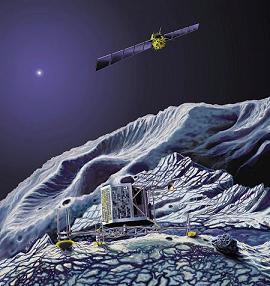This is what an artist thinks the Rosetta lander will look like on the comet's surface.
Click on image for full size
Courtesy of ESA
Rosetta Lander
Part of the Rosetta spacecraft is a lander
that will touch down on the
surface of the comet. Since the comet is much
smaller than a planet or even a
moon, the gravity on the surface is
very weak. The engineers who designed the Rosetta lander had to make sure it
doesn't bounce (and maybe tip
over!) when it lands. The lander will be moving very slowly, about one
meter/second (two miles/hour), when it touches down. It will shoot
harpoons into the icy surface of the comet when it lands. Cables from the
harpoons will help hold the lander down on the surface.
The Rosetta mission was supposed to study a comet named Wirtanen.
There were some problems with the rocket that Rosetta will be launched on,
so Rosetta's launch had to be delayed.
Because of the delay, the mission will now study a different comet. Rosetta
will study Comet
Churyumov-Gerasimenko. The lander will touch down on the nucleus of
Churyumov-Gerasimenko in November 2014. The new comet is much bigger than the
old one, so it has more gravity. That means the Rosetta lander will be going
faster when it lands. Engineers had to make some changes to the legs of the
lander to make sure it has a soft landing on the surface of Comet Churyumov-Gerasimenko.
Instruments on the lander will measure the types of chemicals found on the
surface. The lander also has small drills that will dig into the
comet. Samples dug up by the drills will help us find out what is
"underground" on a comet. The lander also has cameras that will take
pictures from the surface.
You might also be interested in:
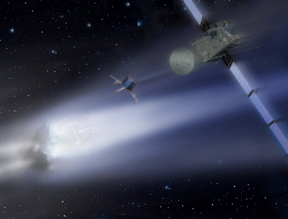
The Rosetta Mission was suppose to launch in January 2003. Unfortunately, the launch had to be delayed! The Rosetta spacecraft was suppose to be launched on an Ariane 5 rocket. A month ago, another Ariane
...more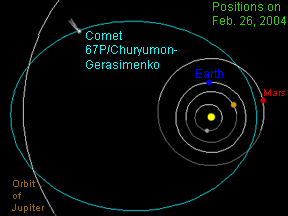
Comet 67P/Churyumov-Gerasimenko was discovered in 1969 by Klim Churyumov and Svetlana Gerasimenko. The comet orbits the Sun once every 6.57 years. Its orbit brings it closer to the Sun than Mars at the
...more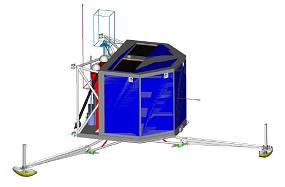
The Rosetta lander has many instruments that it will use to make measurements when it lands on Comet Churyumov-Gerasimenko. The instruments carried by the lander are described in the table below. The instruments
...more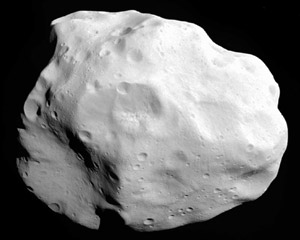
Lutetia is a medium-sized asteroid. It orbits the Sun in the main asteroid belt between the planets Mars and Jupiter. Its official name is "21 Lutetia" because it was the 21st asteroid discovered. Lutetia
...more
Rosetta is a European space probe. It was launched in 2004. Its main mission is to fly to a comet and land on it. Along the way it has flown by two asteroids. In July 2010 it flew by an asteroid named
...more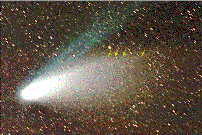
Hale-Bopp continues to offer new surprises as two astronomers report of their study of the comet. Using the Hubble Space Telescope and the International Ultraviolet Explorer, the astronomers did a year-long
...more
Six spacecraft flew by Halley's comet in 1986. There were two spacecraft launched from Japan, Suisei and Sakigake, and two from the Soviet Union, Vega 1 & 2. One spacecraft, ICE, from the United States
...more


